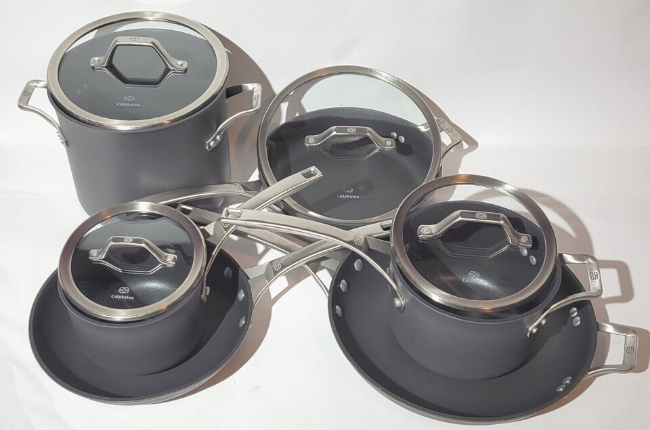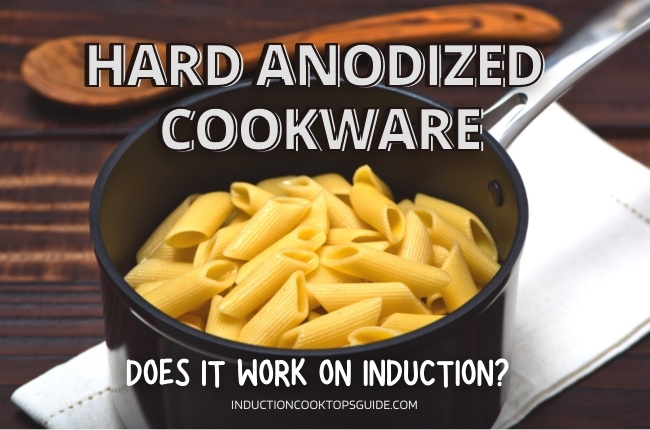If there is one word to describe hard anodized cookware, it would be durable — not induction-compatible.
But with the rise of induction cooktops nowadays, it’s hard to merely ditch every cookware that doesn’t seem to fit the bill. Besides, some companies have already made a move to make induction-compatible pans and pots.
It’s not a leap to say that cookware manufacturers recently joined the trend too. Is hard anodized cookware induction compatible? Read on to find out.
What is hard anodized cookware made of?
If you’ve been to the kitchen section of a store, you probably saw the term “hard-anodized” cookware along with stainless steel, ceramic, etc.
You may recognize it readily from its non-stick feel and charcoal gray or black cooking surface. And although you aren’t entirely sure of what it means, you nod to yourself and chuck it to another fancy-named non-stick type of cookware.
However, there is more to it other than its non-stickiness, of course.
Aluminum is a material with excellent thermal conductivity. It can heat up quickly and drop the temperature relatively fast too. It also distributes heat evenly, so your cookware doesn’t suffer from hot spots.
The base material of hard-anodized pots and pans is aluminum. It then undergoes hard anodizing from soft, silvery-white material to the familiar hardened black surface.
The Science Behind Anodized Cookware
Anodizing aluminum involves dipping it in a sulfuric acid bath and running a low-voltage current. The process deposits aluminum oxide coating on the original aluminum sheet. This thin coating makes aluminum hard and corrosion-resistant.
If you cool the acid bath and amp up the voltage running through it, the method you employ is called hard anodizing.
Hard anodizing ensures that any hole or fissure on the original material gets filled. The thick coating makes it extra durable— points away from the durability that diamond offers.
Ultimately, you end up with cookware that is scratch-resistant to any type of utensils. Yes, even metal!
Moreover, hard-anodized cookware is not only durable. It is also lightweight, resistant to acids and salt (an important quality to ANY cookware), does not corrode, and can tolerate abrasive materials better.
Most importantly, it retains aluminum’s property of great thermal conduction.
What does hard anodized pan mean?
A hard anodized pan means you have chemically-treated, aluminum-based cookware. It’s important to know that while the smoothened surface creates a non-stick feel, hard anodizing doesn’t necessarily equate to being non-stick.
Some food may still stick to it. Only if you see both of those terms together on cookware can you guarantee those properties.
As it is, most companies nowadays already apply a non-stick coating to hard-anodized cookware to improve the resulting quality.
Hard anodized pans are best for liquid and movable food. Since they are more durable, you can clean them gently with a regular scrub brush. They are generally easy to clean, too, due to their smooth surface, so no worries there!
As for storage, their hard surface can scratch other types of cookware, so it’s best to store them at designated racks or cabinets to eliminate the risk of damage.
If you have a hard-anodized pan, you can expect it will not likely chip, peel, or warp any time soon!
Calphalon, All-Clad (HA1 collection), and Anolon are some of the brands with a variety of good quality hard-anodized cookware. They are worth checking out on your next store visit.
Does hard anodized cookware work on induction cooktops?
Induction cooktops require ferromagnetic material to work their magic.
When you go to the store, you don’t need to look for something that says “ferromagnetic”; instead, you only need “induction compatible, induction ready, induction safe” to confirm that your cookware will work on your induction cooktop.
Tip: Stick a magnet to your cookware. If it sticks well to the underside, then you are good to go. If not, your cookware won’t heat up when using an induction cooktop.
Induction works through electromagnetism. The copper coil underneath produces a magnetic field which then makes the ferromagnetic material of your cookware heat up. Cast and enameled iron and some stainless steel cookware are perfect examples.
Aluminum, unfortunately, isn’t one of them. Hard anodized cookware is aluminum-based and, therefore, wouldn’t pass the magnet test either.
Can you use hard anodized cookware on an induction cooktop?

Hard anodized pots and pans may seem a great choice, but even with their incredible qualities, they fall short on the topic of induction.
Nowadays, you can see hard-anodized cookware labeled as induction-ready. How is it possible?
Any material that doesn’t have a ferromagnetic property can still work on induction using either an interface disk or if they have an induction plate built at the bottom.
An induction interface disc works as a mediator. They are discs usually made out of stainless steel. Stainless steel contains iron and, therefore, is ferromagnetic.
An interface disc absorbs the magnetic waves and heats up as a result.
The heat transfers to the pan if you put non-induction-friendly cookware, like hard anodized pans, onto a heated interface disc.
One major throwback to interface discs is the efficiency of heat transferred. There is a huge heat loss compared to directly heating it on the induction cooktop. This may lead to uneven and slow heating.
The other option is to look for an induction plate at the bottom of your cookware. Most companies already have them to accommodate induction cooktops. They are typically of magnetic stainless steel composition.
However, since only the bottom magnetic plate heats up, some heat eventually gets wasted, and the efficiency doesn’t compare to having cast iron, for example.
Can you use anodised pans on induction hob?
Whether it is hard anodized or anodized cookware, you cannot work with them in an induction hob unless you have an induction plate at the bottom or an interface disc.
Another critical requirement is the size of the metallic base. It should be more than 3-4 inches wide to be detectable by the induction cooktop.
Which is healthier: ceramic or hard-anodized cookware?
To make this comparison plausible, one crucial lesson you must know is that “ceramic cookwares” in the market are not 100% ceramic.
It is better to call them ceramic-coated. But even that is a little confusing.
Ceramic-coated cookware is usually aluminum-based. They are not coated with ceramic, too, as the name may imply. A unifying factor among ceramic cookware is they all have sol-gel coating bonded to the surface, which gives them the non-stick property.
The silicone layer forms a glass-like surface and reduces the need for butter or oil beforehand. Most importantly, they are non-toxic.
However, ceramic-coated cookware does not have the same durability and scratch resistance as hard anodized pans. They may chip or peel, which causes the base metal and other reactive substances to leak into your food.
Not only are they not suitable for metal utensils but dishwashers too, since they may gradually break down the coating.
When it comes to health and safety, the thick coating of hard anodized cookware offers greater reliability.
Is hard-anodized cookware safer than stainless steel?
Known for its durability, heat retention, and versatility, stainless steel is primarily a mixture of iron and carbon with a lower percentage of other metals.
You can cook just about everything with stainless steel cookware!
When it comes to safety, both hard anodized and stainless steel cookware are safe.
Over time, your pans may deteriorate, and there would be no possibility of your cookware releasing toxic chemicals into your food. This is especially true for stainless steel than anodized aluminum.
Since stainless steel retains heat better than aluminum, you must always apply caution while cooking.
A stainless steel pan will likely burn you upon contact after several minutes of taking it out from the heated cooktop. Hard anodized aluminum, on the other hand, loses heat relatively quicker.
Stainless steel is also dishwasher friendly, unlike hard anodized cookware. Even if food sticks to stainless steel, you can be assured that you won’t have to hand-wash it!
What are the pros and cons of hard anodized cookware?
By the end of this article, you are probably familiar with the advantages of hard anodized cookware.
They have the three most inviting qualities: durability, scratch resistance, and high thermal conductivity. The non-stick quality also lessens the need for butter and oil beforehand.
Hard anodized cookware heats up quickly and evenly, is stackable on your shelf, and doesn’t require high maintenance. You can also get induction-compatible ones to complement your induction cooktop!
On the other side, hard anodized cookware can be more expensive than regular aluminum pans. They are heavy and not aesthetically pleasing. Over time, you will also notice exterior stains that are hard to remove.
They are not generally safe at high temperatures too. Lastly, the non-stick layer makes it not okay for dishwashers and degrades within 2-3 years.
Should you purchase it?
If you don’t have any aesthetic criteria or qualms about its non-stick lifespan, then definitely go for it!

Leave a Reply